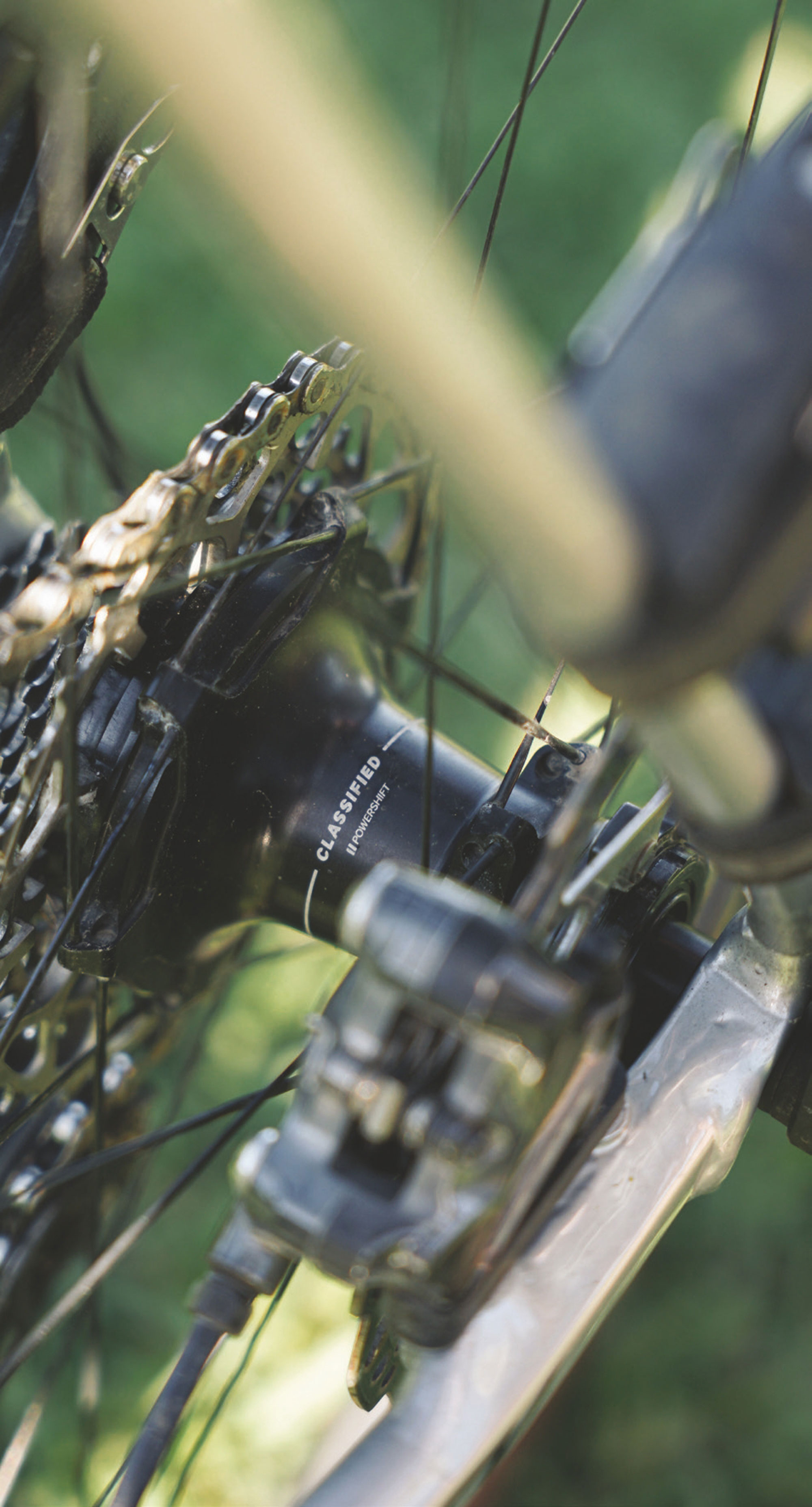Words Lester Perry
Images Jakob Lester
After toiling for hours outside of their day jobs, the founders of Classified developed the Powershift system, ensuring it was refined and accurate enough to make its mark on cycling when it eventually launched in 2019.
With his history in the automotive industry and armed with a PhD and Postdoc in Drivetrain and Transmission technology, founder Roëll van Druten and his team set out to revolutionise bicycle drivetrains. Powershift was created to offer the same functionality as a 2x chainring setup while eliminating all the downsides.
Input from some serious Belgian hitters, Tom Boonen, Victor Campernarts, and Wout van Aert, among others, has meant the system caters to the entire spectrum of cyclists and is fit for the most demanding and powerful riders. Side note: Would you rather spend a night out with Tom Boonen or Wout van Aert? I’m sure the answer to this question would be about as divisive as the argument for or against 1-by or 2-by chainring setups.
Powershift is, for all intents and purposes, a two-speed internal rear hub, but it’s much more than just a hub. After all, we’ve seen geared hubs before; they worked fine, although none have targeted the high-end, high-performance end of the market and all its requirements.
‘Two by’ setups work well, but the number of dropped chains and miss-shifts we see means it’s not a foolproof setup – particularly when ridden off-road, and the rougher tracks are, the worse it is. Efficiency isn’t generally mentioned when discussing 2x systems, but according to Classified’s testing, climbing on a small chainring (i.e. 36t) results in 45% more chain tension than climbing in the big (52t) ring, increasing friction within the chain, bottom bracket, and hub bearings, ultimately sapping power, not to mention the aero-gains on offer from running just a single chainring.
Enter the Classified Powershift system and the ability to run a single, large front chain ring. Not only for its efficiency but thanks to having a second gear available the drawbacks of traditional single- ring systems disappear. To offer true versatility, a single ring needs to be run with a wide-range cassette; for example, a 10-45t cassette on a single ring would be equivalent to running an 11-40t cassette on the Classified two-gear system. The smaller gear spread of the 11-40t combined with Powershift’s two gears, means riders can find a more comfortable cadence through the entire gear range, ultimately helping to save their legs.
Standard 1x systems are inevitably cross-chained at some point, with the chain bending significantly to reach the highest or lowest cogs. Cross-chaining increases friction and decreases efficiency, detonating a chain’s lifespan and wasting precious watts. Given the ability to shift between smaller and larger gears within the Powershift hub, the chain can run in its straightest and most efficient fashion.
The hub offers a 1:1 ratio, equivalent to a standard hub, and a 0.7 ratio. The change in ratio between the two gears is about the equivalent step as found on a 52/39t two-by setup. In the 1:1 ratio, efficiency is claimed to be 99.8%, or the same as a DT Swiss 240 hub, and there is a small drop to 99.2% when in the 0.7 ratio. Rob Britton won the ultra-distance gravel race, Badlands, using a 48t chainring, giving him a 33t ‘little’ gear to help him get up the steep climbs. Regardless of the slight loss of efficiency in the 0.7 ratio, Classified claims an overall net gain in efficiency due to running a larger single chainring, better chain line, and better aerodynamics over a standard 2x setup.
Classified offers a coffee-table book worth of test data (much from third parties) and anecdotal data from a variety of use cases on their website should you want to get into the fine minutia. What I’ve outlined above gives a general gist of the advantages.
Powershift is, for all intents and purposes, a two-speed internal rear hub, but it’s much more than just a hub.
Components
The system consists of 100% proprietary components, including the Hubshell with Powershift internals, Smart Tru Axle, handlebar unit, shifter button, and cassette.
Hubshell and Powershift internals
The hubshell can be purchased by itself, allowing it to be built into a second wheel, simply swapping the Powershift internals between the wheels. The Powershift internals are easy to remove and completely encase the gears and electronics in a waterproof unit. On the non-drive side of the hub is a small Torque arm aka an “External Torque Support” that sits against the brake calliper bolt head below the chain stay. The hub transmission consists of a planetary gear set of an external Ring gear that surrounds the six Planet gears, which rotate around a Sun gear. It all sounds like astronomy to me, and the physics of how it all works is over my head. It works, though; there’s no denying that.
Handlebar unit and shifter button
The shifter button is mounted on the handlebar just below the inside of the left brake hood, the same way a traditional sprint shifter is. A small wire runs from the button under the bar tape to the Handlebar Unit, which is neatly tucked in the bar end. When the shift button is pressed, the handlebar unit transmits a shift signal over Bluetooth to the Smart Thru Axle. The shifter works great, although the button is quite small and doesn’t feel particularly bombproof. Fortunately, it’s tucked away in an area that is unlikely to see any impact during a crash.
Smart Thru Axle
The Classified Smart Thru Axle does more than just hold the rear wheel in the dropouts. The axle handle works as an aerial, receiving the shift signal from the handlebar unit and then wirelessly triggering a shift within the hub. It is very smart indeed! To ensure maximum compatibility, the threaded end of the axle can be swapped out to a different thread pitch, depending on the intended frame it’s to be installed on. The thread can be rotated to allow the optimal angle on the handle/aerial once it’s tightened – the aerial is best pointing forward, directly at the handlebar unit, so fine-tuning where it sits when the axle is tight is vital. As far as the usability of the Smart Thru Axle goes, my wheel hasn’t fallen out of the bike at all and the connection between the handlebar unit and the aerial has been flawless.

Nada, no dice, no diggity; I couldn’t get the shift to be anything but precise and perfect. I would say I was frustrated I couldn’t get it to skip a beat, but honestly, I'm astounded by how perfectly it changes gears.
Classified Cassette
Part of the quest to keep the system weight competitive with a standard drivetrain has led Classified to develop a proprietary cassette. Reminiscent of a SRAM RED Powerdome cassette, all Classified cassettes are milled from a single piece of steel. The hollow relief in the back of the cassette makes room for the hubs larger than normal freehub mechanism and the planetary gears of the system; hence, a regular cassette can’t be used. The cassette is finished with a high-durability coating to aid longevity. Multiple cassette sizes are available depending on the use case. My test bike was fitted with the 11-34t, 11-speed option, paired with a KMC chain and Shimano GRX derailleur. The cassette is a true work of art. Classified obviously did their homework when designing it. For the life of me, though, I couldn’t get a 100% crisp shift out with a mechanical setup; even after an inspection and tune from a reputable mechanic, we just couldn’t get it to the level of a standard GRX HG800 cassette. I’m wondering if the combination of the chain used and the Classified Cassette isn’t quite right. It by no means was unacceptable, but it was just a bit of a niggle with the odd slow shift.
Using the Classified Powershift system
I’ve put in a solid month aboard the Classified Powershift, logging miles on my local sealed and gravel roads and fully loaded while touring the tracks on Aotea Great Barrier Island, for a few days. So what did I reckon?
First, the shifter button takes a bit of getting used to, but where it’s situated on the handlebars lets you shift whether you’re on the hoods, or in the drops. A simple push of the button and the hub silently shifts between gears. It takes some time to get used to the sensation because it can be shifted while not pedalling at all or halfway through an effort under significant power (up to 1000 watts). There are no halfway shifts or need to back off the power. It certainly takes some time to get used to as it’s quite a different sensation to a front derailleur shift.
Oh, and the system is completely silent while coasting. There’s no buzz of a freehub, so if you need the sound of 1000 bees in a tin can, then this isn’t for you. I found it strangely refreshing to have a bike that was all but silent while descending; it added to the mystique of the system, for sure.
I tried to fault the shift on every ride, shifting in the worst possible times, with what I thought would be too much power. I even tried to quickly shift then pedal half a crank backwards, then forwards into a full sprint. Nada, no dice, no diggity; I couldn’t get the shift to be anything but precise and perfect. I would say I was frustrated I couldn’t get it to skip a beat, but honestly, I’m astounded by how perfectly it changes gears.
The simplicity of a single-ring setup with the advantages of a two-by system shines while riding off-road or on mixed terrain, and this really hit home when touring Aotea, Great Barrier Island. Cruising on the sealed roads, rolling in the ‘big’ gear and shifting through the close ratios on the cassette gave me some serious road bike vibes. When I turned off the seal and onto the steeper off-road trails, or if I got caught out at the base of a surprise pinch climb, the ability to essentially dump a bunch of gears in one click and spin my way up some serious climbs in the ideal cadence (most of the time) was great too, no need to mash the chain across an entire cassette to the ‘granny’ gear.
On one particular pinch on Great Barrier Island, I was down to the easiest gear, barely able to grind my way up a climb. Even with a full-body effort, I was creeping. Then my handlebar bag’s contents shifted, and the bag bumped the shifter button, shifting from the low up to the high gear, all while I was grinding up the hill; according to Strava I was doing 448 watts (from a power meter), at 48RPM, and it shifted up to the high gear without skipping a beat. My cadence dropped significantly, and a couple of seconds later, I tipped over into the grass on the side of the trail; the step up in gear had cracked me!
The major difference between using a regular 1-by setup and the Classified Powershift system is that I’m shifting more on the Classified – just like when using a two-by setup. The shift up to the 1:1 ratio I find usually needs to be accompanied by two shifts down (easier) on the rear cassette to maintain cadence, and visa versa; when shifting down to the 0.7 ratio, a couple of gears higher are needed on the rear – exactly like on my personal two-by GRX 810 equipped gravel bike. Does this mean there’s actually no advantage in a Powershift system over a two-by? Well, in some cases, yes.
So where does all this leave us? Who is the ideal user or target market for Powershift? Here’s my take; If you’re riding a road bike on the average sealed roads in NZ, and you have electronic front shifting, I don’t think the advantages of changing to a Powershift hub are worth the price of admission.
If you’re a bit more of an allrounder, maybe on a gravel bike or at least an all-road style bike that sees the dirt or gravel a reasonable amount, then a Powershift system could be a great asset, regardless if you’re running a single front ring or double chainrings currently. If you’re coming off a 2-by, there’s peace of mind that you’ll probably never drop a chain again, you’ll never experience a dodgy front shift, and you’ll be able to shift between your two ‘main’ gears regardless of the conditions you are riding in and how grimy your chain has become.
If you’re accustomed to riding a single-ring setup then adding a powershift will take some getting used to, although it really expands the options for the terrain you can ride comfortably, and how you ride it. Personally, I’m a stickler for the most comfortable cadence and find that on huge rides, the ability to stay in my cadence ‘sweet spot’ keeps my legs fresh for much longer.
Anyone into ultra-cycling events or bikepacking would benefit hugely from the system. The simplicity of the single ring combined with the advantages of the two-by-range and close gears would pay dividends over multiple days, particularly in mountainous areas.
If money was no object, I’d buy a Powershift system for my gravel bike, dropping my double chainrings and building the hub into some modern rims, something mid-depth with wide internal measurements and carry that wheelset forward onto my next few bikes.



